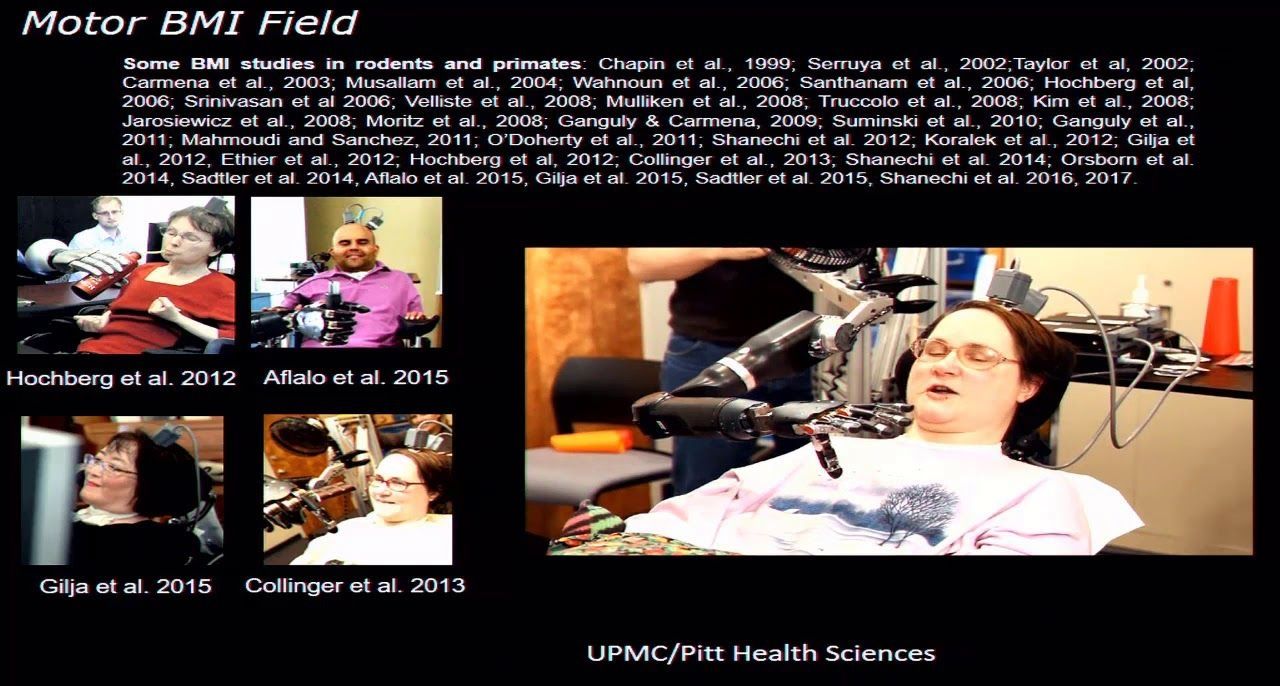Page 9704
Jun 28, 2018
Power-multiplying exoskeletons are slimming down for use on the battlefield
Posted by Genevieve Klien in categories: cyborgs, energy, military
Dashing around a battlefield in the bulky robo-armor Tom Cruise wore in Edge of Tomorrow won’t cut it in the real world. For starters, it’s way too big. And the energy required to power something that size—via a gas engine strapped to your back in some early inventor iterations—is noisy and a giveaway to the enemy that you’re approaching.
But a raft of newly developed exoskeletons is starting to meet the slimmed-down, stealth requirements of today’s troop commanders, who see these power-assisting suits as vital to the future combat missions. Among the most promising, and weird-looking, is the “third arm” that the U.S. Army Research Laboratory developed to help soldiers carry and support their weapons on the battlefield. The lightweight device, which weighs less than four pounds and hangs at a soldier’s side, stabilizes rifles and machine guns, which can weigh up to 27 pounds. This improves shooting accuracy and also minimizes fatigue. It can even be used while scrambling into position on the ground.
The kind of fatigue that the third arm aims to negate is a killer on the battlefield, and most of the new suits are similarly meant to help troops minimize the energy they use to carry enormous supply packs, weapons and other battlefield gear. In May, Lockheed Martin unveiled its lightest weight powered exo for lower body support. Dubbed ONYX, the form-fitting suit, which resembles an unobtrusive web of athletic braces, reduce the effort soldier’s need for walking, running, and climbing over varied terrain while carrying a heavy loads of up to 100 pounds.
Jun 28, 2018
‘Breakthrough’ algorithm exponentially faster than any previous one
Posted by Dan Kummer in categories: biotech/medical, information science, robotics/AI
What if a large class of algorithms used today—from the algorithms that help us avoid traffic to the algorithms that identify new drug molecules—worked exponentially faster?
Computer scientists at the Harvard John A. Paulson School of Engineering and Applied Sciences (SEAS) have developed a completely new kind of algorithm, one that exponentially speeds up computation by dramatically reducing the number of parallel steps required to reach a solution.
The researchers will present their novel approach at two upcoming conferences: the ACM Symposium on Theory of Computing (STOC), June 25–29 and International Conference on Machine Learning (ICML), July 10 −15.
Continue reading “‘Breakthrough’ algorithm exponentially faster than any previous one” »
Jun 28, 2018
A New Study Is Questioning The Limits of Human Lifespan
Posted by Nicholi Avery in category: life extension
Jeanne Louise Calment lived for 122 years and 164 days, the oldest verified age of any person, ever. Her interviews revealed a portrait of the centenarian in high spirits: “I’ve only ever had one wrinkle, and I’m sitting on it,” she told reporters when she turned 110.
Calment died in 1997 in Arles, France, where she spent much of her impressively long life. No one else, according to accurate records, has lived beyond 120 years.
Whether there’s a limit to the human life span is an age-old question. An actuary named Benjamin Gompertz proposed in 1825 that mortality rates accelerate exponentially as we grow older.
Continue reading “A New Study Is Questioning The Limits of Human Lifespan” »
Jun 28, 2018
The State of Brain-Machine Interfaces
Posted by Marcos Than Esponda in categories: biotech/medical, genetics, neuroscience

Maryam shanechi, university of southern california.
With recent technological advances, we can now record neural activity from the brain, and manipulate this activity with electrical or optogenetic stimulation in real time. These capabilities have brought the concept of brain-machine interfaces (BMI) closer to clinical viability than ever before. BMIs are systems that monitor and interact with the brain to restore lost function, treat neurological disorders, or enhance human performance.
Jun 28, 2018
Dark Matter ‘Test’ Will Either Prove Its Existence or Modify Gravity
Posted by Genevieve Klien in categories: computing, cosmology
For something that supposedly takes up 80 percent of the total mass of the universe, we don’t know a whole lot about dark matter. Sometimes the lightless stuff reveals hints about its shape; other times it completely thwarts any evidence supporting its existence. Since we can’t observe it first-hand, we rely on indirect means to suss out information about it, like watching the interactions between other forms of matter. Now, scientists have developed a new “test” to make those investigations more definitive, leading us closer to answering the question: Is dark matter even real? And if it’s not, then is everything we know about gravity wrong?
In a study, published Monday in Physical Review Letters, a team of scientists from the University of Bonn that also includes Hubble Fellow Marcel S. Pawlowski, Ph.D. of the University of California, Irvine, introduce a computer model that can simulate how certain small galaxies should move if dark matter exists. Though dark matter does not absorb or emit light, it still interacts with visible matter through gravity, so it’s expected to make the stars around galaxies move in specific ways.
Pawlowski explains to Inverse in an email that within the little galaxies in question — satellite “dwarf” galaxies, crowding around the edges of big galaxies like the Milky Way — the acceleration of stars speeding around the galaxy’s center is described by a term called the radial acceleration relation, or RAR. “With the new study, we simulate such dwarf galaxies under the assumption of the ‘standard’ dark matter model, [to] determine what kind of behavior would be expected for the dwarfs,” he says. “We find that the simulated dwarf galaxies largely continue the RAR to lower accelerations.” Now that they know how those dwarf galaxies are supposed to move if dark matter exists, they can compare the simulations to real-life data on the movement of those galaxies.
Continue reading “Dark Matter ‘Test’ Will Either Prove Its Existence or Modify Gravity” »
Jun 28, 2018
Niantic will offer AR platform to third-parties, including AI object recognition
Posted by Genevieve Klien in categories: augmented reality, robotics/AI

Apple’s ARKit and Google’s ARCore may have multi-million-user installed bases, but so does Niantic’s Pokémon Go, the first hit augmented reality game. Now Niantic plans to offer its custom AR software to other developers as the Real World Platform, and is teasing advanced features that go beyond the capabilities of Apple’s and Google’s development kits.
Already used in Pokémon GO, Ingress, and Harry Potter: Wizards Unite, the Real World Platform is an evolving software engine that adds digital characters and shared social experiences to real-world map data. Niantic has recently bolstered the AR platform’s development team by acquiring computer vision specialist companies Escher Reality and Matrix Mill, the latter with machine learning expertise.
Jun 28, 2018
A Flu Drug May Be Poised to Upend Treatment in U.S.
Posted by Genevieve Klien in category: biotech/medical
The medication can reduce the duration of symptoms.
- By Helen Branswell, STAT on June 28, 2018
Jun 28, 2018
Once-Dreaded Poliovirus Could Treat Brain Cancer
Posted by Genevieve Klien in categories: biotech/medical, genetics, neuroscience
Polio was a devastating disease before the development of the polio vaccine. But now, this once-feared virus might help treat another deadly illness — brain cancer.
In a new study, some patients who had an aggressive type of brain cancer called glioblastoma and who received a genetically modified poliovirus lived much longer than typical for these patients.
The study found that about 21 percent of the brain cancer patients who received the poliovirus therapy were alive three years later. In contrast, among a group of previously treated patients who had the same cancer but received standard therapies (such as chemotherapy), just 4 percent were alive after three years.
Continue reading “Once-Dreaded Poliovirus Could Treat Brain Cancer” »
Jun 28, 2018
Zoltan Istvan: It Goes beyond Human
Posted by Zoltan Istvan in categories: employment, geopolitics, policy, robotics/AI, security, transhumanism
I’m excited to share my interview with Jakub Dymek on #transhumanism in the new edition of The Aspen Institute (Eastern Europe) quarterly Aspen Review magazine.
Let’s think about this: what happens when sometime in the future the whole generation of Chinese kids have higher IQs than their American peers, because they’re technologically hardwired for that? Will this be a national security issue? This is a global security issue—says Zoltan Istvan in an interview with Jakub Dymek.
JAKUB DYMEK: You are a transhumanist—member of a movement endorsing technologically augmented advancement of human species and using technology to extend our capabilities. What does transhumanist thinking bring into the world of policy debate in the US and worldwide and how politically influential it is?
















